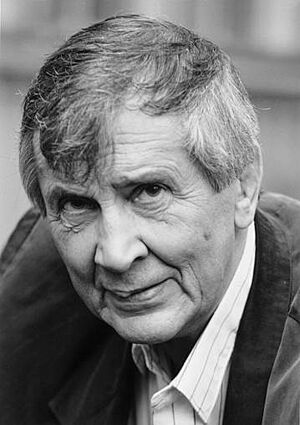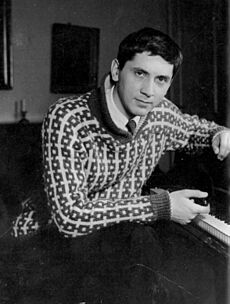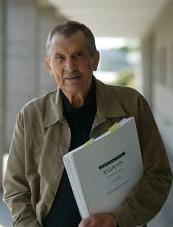Einojuhani Rautavaara facts for kids
Quick facts for kids
Einojuhani Rautavaara
|
|
|---|---|

Rautavaara, c. 2000
|
|
| Born | 9 October 1928 Helsinki, Finland
|
| Died | 27 July 2016 (aged 87) Helsinki, Finland
|
|
Notable work
|
Piano Concerto No. 1 Cantus Arcticus Symphony No. 7 (Angel of Light) List of compositions |
| Spouse(s) |
Mariaheidi Suovanen
(m. 1959; div. 1984)Sinikka Koivisto
(m. 1984) |
| Children | 3 (including Markojuhani) |
Einojuhani Rautavaara (born 9 October 1928 – died 27 July 2016) was a famous Finnish composer of classical music. He is one of the most important Finnish composers after Jean Sibelius.
Rautavaara wrote many different kinds of music. These include eight symphonies, nine operas, and fifteen concertos. He also wrote many pieces for voices and small groups of instruments. His early music used a style called 12-tone serial techniques. Later, his music became more romantic and often had a mystical feeling. Some of his most famous works are his first piano concerto (1969), Cantus Arcticus (1972), and his seventh symphony, Angel of Light (1994).
Contents
Life
Einojuhani Rautavaara was born in Helsinki, Finland, in 1928. His father, Eino Alfred Rautavaara, was an opera singer. His mother, Elsa Katariina Rautavaara, was a doctor. Einojuhani started learning piano when he was young. His father passed away when Einojuhani was 10. His mother died less than six years later. He then went to live with his aunt in Turku. There, he began taking formal piano lessons at age 17.
Rautavaara studied music at the University of Helsinki. He also studied composing at the Sibelius Academy from 1948 to 1952. He became known around the world in 1954. This happened when he won a contest for his piece A Requiem in Our Time. Even though he said he had little experience, Jean Sibelius suggested he get a scholarship. This scholarship allowed him to study at the Juilliard School in New York City. He also took lessons from other famous composers like Aaron Copland. Rautavaara later said that living in Manhattan taught him a lot about life.
After returning to Helsinki, he graduated from the Sibelius Academy in 1957. He continued his studies in Switzerland and Cologne, Germany.
Rautavaara worked as a teacher at the Sibelius Academy. He was also a music archivist for the Helsinki Philharmonic Orchestra. From 1976 to 1990, he was a professor of composition at the Sibelius Academy. Some of his students became famous composers and conductors.
He married Heidi Maria "Mariaheidi" Suovanen in 1959. They had two sons and one daughter. Later, he married Sinikka Koivisto in 1984.
In 1985, Rautavaara received the Finnish State Prize for Music.
In 2004, he had a serious health issue. He spent several months in the hospital. The Finnish government supported him during this time. They named him an arts professor, which meant he was paid just to compose. He passed away on 27 July 2016 in Helsinki.
Music
Rautavaara wrote a lot of music in many different styles. His music can be divided into four main periods. First, an early period in the 1950s that was more traditional. Second, an experimental period in the 1960s where he tried new techniques like serialism. Third, a more romantic period in the late 1960s and 1970s. Finally, a "post-modern" style where he mixed many different techniques.
A common theme in his music is "mysticism." He was very interested in spiritual and religious topics. Many of his works have titles that mention angels. He wrote eight symphonies, 15 concertos, and many pieces for choirs. He also composed sonatas for different instruments and string quartets. His operas often told stories about famous people, like Vincent (about Vincent van Gogh) and Rasputin.
How he composed
Rautavaara often compared composing to gardening. He said that music should "grow organically" like plants. He believed that a composer observes and guides this growth. He liked his music to be "freely growing and organic," like an English garden. He would often choose the instruments for a piece first. Then, the music would develop naturally from that idea.
Music in the 1960s

In the early 1950s, Rautavaara was one of the first in Finland to use serialism. This is a way of composing music using a specific order of notes. His Third and Fourth Symphonies used this style. He also wrote an opera called Kaivos (The Mine). Even with serialism, his music still sounded romantic. He even called his Third Symphony the "Bruckner symphony," after the romantic composer Anton Bruckner.
Using these new techniques made Rautavaara a talked-about figure in Finnish music. However, in the mid-1960s, he felt stuck with serialism. He found it too difficult and not creative enough. He realized it was "not a road for me to follow." He then started trying different styles. His Cello Concerto No.1 (1968) and Anadyomene (1968) helped him break free. His new music began to mix different styles. This included soft, romantic sounds and modern ideas.
Music in the 1970s
The 1970s were a very busy time for Rautavaara. He felt he had found his unique musical voice. He wrote a lot of music during this period. Choirs especially liked his new, soft style. They asked him to write many choral songs. His major choral works include Vigilia and True and False Unicorn. Cantus Arcticus came out in 1972.
In the 1970s, Rautavaara also started writing more operas. His later operas, like Thomas (1985), Vincent (1987), and The House of the Sun (1991), became very successful around the world. Other operas he wrote include The Gift of the Magi (1994) and Rasputin (2003).
Some of his works use magnetic tape. This means they include recorded sounds. For example, Cantus Arcticus (1972) uses recorded bird songs with an orchestra. True and False Unicorn (1971) uses tape along with singers and an orchestra.
Music in the 1980s and 1990s
In the late 1970s, Rautavaara started blending different styles even more. This can be heard in his Organ Concerto "Annunciations" (1977) and Violin Concerto (1977). His orchestral work Angels and Visitations (1978) is a great example. It was the first in his "Angel" series. This series also includes his Seventh Symphony "Angel of Light".
His opera Thomas (1985) showed his mature opera style. It mixed romantic sounds with modern techniques. The story, written by Rautavaara, is about a 13th-century Bishop of Finland. His next opera, Vincent (1987), was about the painter Vincent van Gogh. These operas, along with The House of the Sun (1991), brought him international fame.
His most famous work, the Seventh Symphony, won a Cannes Classical Award. It was also nominated for a Grammy award.
Other important works from this time include the Sixth Symphony "Vincentiana" (1992). This symphony was based on his opera Vincent. He also wrote the Third Piano Concerto "Gift of Dreams" (1998) and the orchestral work Autumn Gardens (1998). His Eighth Symphony "The Journey" was written for the Philadelphia Orchestra.
Music in the 2000s
Rautavaara continued to compose in the 2000s. His works from this period include Book of Visions (2003–2005) and Manhattan Trilogy (2003–2005). He also expanded an earlier piano piece into Before the Icons (2005). In 2005, he finished Lost Landscapes for violin and piano. His orchestral work A Tapestry of Life was first performed in 2008. He also wrote a percussion concerto called Incantations (2008) and a second cello concerto Towards the Horizon (2009).
Music in the 2010s
In 2010, Rautavaara's "Christmas Carol" was performed by the choir of King's College, Cambridge. In 2011, he finished two larger pieces: Missa a Cappella and Into the Heart of Light.
His last major work for violin and orchestra was called Fantasia. It was recorded and released after his death in 2016. It was first performed in Helsinki in December 2018.
After his funeral, two unfinished serenades for violin and orchestra were found. They were called Sérénade pour mon amour (Serenade to My Love) and Sérénade pour la vie (Serenade to Life). One of his students, Kalevi Aho, helped finish the second serenade. These serenades were first performed in February 2019.
Discography
Most of Rautavaara's music has been recorded by the record label Ondine. This includes all of his symphonies and several operas. Some of his major works have also been recorded by Naxos. An album of his vocal works was recorded by BIS Records.
In 2019, a recording of Lost Landscapes was released. Other musicians have also recorded this piece.
See also
 In Spanish: Einojuhani Rautavaara para niños
In Spanish: Einojuhani Rautavaara para niños




